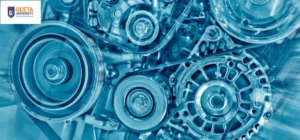Embracing Circular Economy and Sustainable Materials: A Path to a Greener Future
- August 10, 2024
- Geeta University
Introduction
The linear economy model, characterized by a ‘take, make, dispose’ approach, has long dominated industrial practices. This model leads to substantial waste and environmental degradation. In contrast, the circular economy (CE) offers a transformative vision for a sustainable future. By designing out waste, keeping products and materials in use, and regenerating natural systems, the circular economy aims to create a closed-loop system that mimics natural ecosystems.
Principles of Circular Economy
1. Design for Longevity
Key Aspects:
● Durability: Products are designed to last longer, reducing the frequency of replacement. This includes using robust materials and high-quality manufacturing processes.
● Repairability: Easy-to-repair products can extend their lifespan. This might involve modular design, where individual components can be replaced or upgraded.
● Modularity: Products are constructed with interchangeable parts, making it easier to upgrade or repair specific components without discarding the entire product.
Examples:
● Fairphone: A smartphone designed with modular components that users can easily replace, promoting longevity and reducing electronic waste.
● IKEA: The furniture giant has launched a modular sofa that allows customers to replace or add parts to extend its lifespan.
2. Resource Efficiency
Key Aspects:
● Optimal Use of Resources: Efficient use of raw materials during manufacturing processes to minimize waste.
● Closed-loop systems: Involve the continuous recycling and reuse of materials, ensuring that they remain in use for as long as feasible.
● Energy Efficiency: Reducing the energy required for production and operation of products.
Examples:
● Philips: Their lighting products are designed for high energy efficiency and recyclability, ensuring materials are reclaimed and reused.
● Tesla: Employs energy-efficient manufacturing processes and designs batteries for second-life applications in energy storage systems.
3. Waste as a Resource
Key Aspects:
● Recycling: Transforming waste into new materials and products.
● Upcycling: Converting waste materials into new products of higher value.
● Industrial Symbiosis: Waste or by-products of one process are used as raw materials for another process.
Examples:
● Ecovative: Uses mycelium technology to create biodegradable packaging from agricultural waste.
● Kalundborg Eco-Industrial Park: An industrial symbiosis example where waste from one company serves as a resource for another, reducing overall waste and resource consumption.
4. Regenerative Design
Key Aspects:
● Restoring Natural Systems: Practices that contribute to the regeneration of ecosystems and biodiversity.
● Circular Agriculture: Techniques such as agroforestry, crop rotation, and organic farming that enhance soil health and biodiversity.
● Water Reuse and Management: Technologies and processes that recycle and purify water for reuse in industrial and agricultural processes.
Examples:
● The Ellen MacArthur Foundation: Advocates for regenerative agricultural practices that improve soil health and sequester carbon.
● Aquaponics Systems: Combine fish farming with hydroponics to create a closed-loop system where waste from fish provides nutrients for plants, and plants help purify water for the fish.
Implementing Circular Economy Principles
1. Lifecycle Thinking: Consider the entire lifecycle of products from design and production to use, disposal, and regeneration. This holistic view helps identify opportunities for extending the product’s life and integrating end-of-life recycling or upcycling strategies.
2. Collaboration Across Sectors: Effective circular economy practices often require collaboration between businesses, governments, and communities. This can include sharing resources, knowledge, and infrastructure to create symbiotic relationships that benefit all parties involved.
3. Innovative Business Models:
○ Product-as-a-Service: Refers to the practice of offering things as services rather than selling them outright. For example, instead of selling a washing machine, a corporation can provide it on a lease basis, assuming responsibility for maintenance and guaranteeing proper recycling at the end of its lifespan.
○ Sharing Economy: Platforms that allow sharing of resources (like cars, tools, or accommodation) can reduce the need for new products and maximize the use of existing ones.
4. Policy and Regulation: Governments can facilitate the transition to a circular economy through supportive policies and regulations, such as:
○ Extended Producer Responsibility (EPR): Manufacturers are responsible for the entire lifecycle of their products, including take-back, recycling, and final disposal.
○ Incentives for Sustainable Practices: Tax breaks, grants, and subsidies for businesses that adopt circular economy practices.
○ Standards and Certifications: Developing and enforcing standards for product durability, recyclability, and sustainable sourcing of materials.
5. Consumer Engagement: Educating consumers about the benefits of circular economy practices and encouraging sustainable consumption patterns. This can involve campaigns to promote the purchase of durable, repairable, and recyclable products, as well as participation in recycling programs.
Sustainable Materials in the Circular Economy
Sustainable materials play a pivotal role in the circular economy by reducing environmental impacts and enabling resource efficiency.
1. Biodegradable Materials
Biodegradable materials are designed to break down into natural elements within a short time after disposal. Examples include:
● Polylactic Acid (PLA): Derived from renewable resources like corn starch, PLA is used in packaging, textiles, and disposable tableware. It decomposes in industrial composting facilities.
● Mycelium: A mycelium-based substance utilized for packaging and construction purposes. It exhibits rapid growth and undergoes natural decomposition.
2. Recycled Materials
Recycling converts waste into fresh materials, hence diminishing the demand for primary resources. Illustrative instances encompass:
● Recycled Plastics: Polyethylene terephthalate (PET), high-density polyethylene (HDPE), and various other types of plastics can undergo the process of recycling to be transformed into new items such as bottles, textiles, and construction materials.
● Recycled Metals: Metals such as aluminum and steel can undergo multiple cycles of recycling without experiencing any degradation in quality, hence diminishing the necessity for mining.
3. Bio-based Materials
These materials are derived from biological sources and are often renewable. Examples include:
● Bamboo: Used in construction, textiles, and household items, bamboo grows rapidly and requires minimal pesticides.
● Hemp: Utilized for textiles, construction materials, and bioplastics, hemp is a fast-growing crop with low environmental impact.
4. Innovative Materials
Advanced materials engineered for sustainability include:
● Graphene: A single layer of carbon atoms arranged in a lattice, graphene is incredibly strong and lightweight. It’s used in electronics, composites, and energy storage.
● Aerogels: Lightweight and porous, aerogels are used in insulation, filtration, and energy storage. They are derived from silica, carbon, or polymers.
Detailed Case Studies in Circular Economy
The transition to a circular economy involves innovative practices across various industries. Here, we’ll explore detailed case studies of companies that have successfully implemented circular economy principles, demonstrating the diverse approaches and significant benefits of this model.
1. Interface Carpets
Interface is an internationally recognized producer of modular carpet tiles. The company has dedicated itself to sustainability and the circular economy by implementing the “Climate Take Back” and “Mission Zero” initiatives. Interface’s carpet tiles are engineered to be easily replaceable, enabling consumers to replace only the worn or damaged sections rather than the entirety carpet. This approach minimizes waste and expands the product’s lifespan.
Interface’s ReEntry program reclaims old carpet tiles from customers. These tiles are then separated into their constituent materials, which are recycled into new products. This closed-loop process minimizes waste and reduces the need for virgin materials. Interface incorporates a significant amount of recycled content into its products. For instance, they use recycled nylon from old fishing nets and other waste streams in their carpet tiles. This not only diverts waste from landfills but also reduces the environmental impact of their products.
By 2020, Interface had reduced its greenhouse gas emissions by 96% and achieved 89% renewable energy use in its manufacturing processes. The company’s innovative approach to design and materials has set a benchmark in the industry for sustainability.
2. Patagonia
Patagonia has incorporated circular economy principles into its business model, with an emphasis on the recycling, repairability, and longevity of its products. Patagonia’s Worn Wear program promotes the purchase of pre-owned apparel and the repair of existing gear as an alternative to purchasing new items. The initiative provides customers with the opportunity to exchange their outdated Patagonia apparel for store credit, which is subsequently washed, repaired, and resold. This initiative reduces pollution and extends the lifespan of products.
Patagonia offers a comprehensive range of product repair services. They provide DIY repair guides and supplies to enable customers to repair their equipment at home, and they have repair centers located worldwide. This emphasis on repairability contributes to the extended lifespan of products. Patagonia employs recycled nylon and polyester that are derived from plastic bottles. This method not only reduces the necessity for virgin materials but also minimizes energy consumption and waste.
3. Loop
The objective of Loop is to eliminate the production of disposable packaging waste by implementing a closed-loop system that entails the collection, cleansing, and replenishment of packaging materials. The environmental impact and waste associated with single-use packaging are significantly reduced by this system.
Loop collaborates with well-known brands like Procter & Gamble, Unilever, and Nestlé to offer a wide range of products in reusable packaging. By involving major brands, Loop has been able to scale its impact and reach a broad customer base. The reusable containers used by Loop are designed to be durable and attractive, enhancing the customer experience while promoting sustainability. The containers are made from materials like stainless steel, glass, and durable plastics, ensuring they can be reused many times.
Loop also provides an innovative solution to the logistics of reusable packaging. Customers can return their empty containers by scheduling a pickup or dropping them off at designated locations. This convenience encourages participation and helps close the loop on packaging waste. Loop’s model demonstrates how collaboration between companies and innovative logistics can create a sustainable packaging system, significantly reducing the environmental footprint of consumer products.
4. Renault
Renault, the French automotive manufacturer, has implemented circular economy principles in its operations, with an emphasis on sustainable materials, recycling, and remanufacturing. Renault’s dedication to the circular economy is illustrated by its remanufacturing facility in Choisy-le-Roi, France. The facility disassembles used vehicle parts, refurbishes them, and reassembles them into new components.
Renault recycles or reuses these vehicles in new automobiles, recovers valuable materials, and dismantles them. This closed-loop system reduces the demand for new basic materials and minimizes waste. Renault Zoe, an electric vehicle, is composed of 22.5 kg of recycled plastics, which includes components derived from repurposed bumpers and other plastic components.
Renault has established a more sustainable business model and minimized its environmental impact by incorporating circular economy practices into its manufacturing processes. The automotive industry can transition toward a circular economy through the company’s efforts in remanufacturing, recycling, and the use of sustainable materials.
Technical Considerations in Circular Economy
Transitioning to a circular economy entails numerous technical hurdles and technologies. These issues encompass material traceability, product design, recycling technology, and supply chain integration. To ensure that circular economy concepts are implemented efficiently, each of these domains demands modern technical solutions and coordinated efforts.
Material traceability is critical to preserving the integrity of a circular economy. Blockchain offers a transparent and tamper-proof solution for documenting the lifespan of materials. Each transaction or change in the material’s condition is recorded in a block, resulting in a trackable chain of custody. This system ensures that all stakeholders have correct information regarding the material’s origin, application, and recycling procedures. Digital twins, or virtual versions of actual assets, processes, or systems, can be utilized to monitor and track material lifecycles in real time. Companies may maximize the utilization of products and materials by simulating their lifecycles and ensuring they adhere to circular principles. RFID tags and Internet of Things (IoT) devices can be used to monitor and track goods and products, allowing for real-time data collecting and monitoring.
Designing products for a circular economy necessitates a change away from standard linear design approaches and toward those that stress durability, repairability, and recycling. Products should be built such that components can be easily separated at the end of their useful life, allowing for individual part recycling and reuse. Using standardized screws, clamps, and connectors rather than glue and welding facilitates disassembly. Using fewer materials and avoiding dangerous compounds can help to simplify the recycling process. Products should also be built to be modular, allowing for quick upgrades and repair. Modular design allows worn or outdated components to be replaced without discarding the entire product.
Advanced recycling technologies are critical for processing materials in a circular economy. Mechanical recycling, which includes physically breaking down materials into their constituent parts, is widely utilized for plastics, metals, and paper. However, mechanical recycling can lead to material degradation over time. Chemical recycling degrades materials at the molecular level, enabling the recovery of high-quality raw materials. This technique can manage complex and polluted waste streams that are unsuitable for mechanical recycling. Pyrolysis, a sort of chemical recycling, is the process of heating organic materials in the absence of oxygen to produce oil, gas, and char, which can then be utilized to make new goods. Recycling methods must be scalable, cost-effective, and able to handle a wide range of waste streams.
Supply chain integration is critical to the successful application of circular economy principles. Collaboration among stakeholders, including suppliers, manufacturers, and recyclers, is required to develop closed-loop systems. Digital platforms may help with information sharing and coordination, ensuring that goods move smoothly across the supply chain. Reverse logistics, or the gathering and delivery of spent items and materials back to producers or recyclers, is an important component of the circular economy. Efficient reverse logistics systems can save costs and environmental impact. Advanced analytics and machine learning can help businesses manage supply chain operations, predict material flows, and find opportunities for recycling and reuse.
Governments and regulatory agencies play critical roles in facilitating the transition to a circular economy. Policies and regulations that encourage circular practices, such as extended producer responsibility (EPR) and eco-design requirements, can accelerate industry-wide adoption. Governments can also offer incentives to firms to invest in circular technology and processes, such as tax breaks, grants, and subsidies. Public awareness campaigns can inform consumers and businesses on the advantages of the circular economy, encouraging involvement and support. Collaboration between the public and business sectors is critical to establishing a supporting ecosystem for circular economy efforts.
To summarize, technological considerations in a circular economy require a complete strategy that incorporates material traceability, product design, recycling technology, and supply chain integration. Advanced technologies and joint efforts are required to overcome obstacles and reap the benefits of a circular economy. Businesses and societies may construct sustainable and resilient systems by addressing these technical considerations.
Policy and Regulatory Support
It includes:
● Incentives: Tax breaks, subsidies, and grants for companies adopting circular practices.
● Regulations: Mandating recycling, extended producer responsibility (EPR), and eco-design standards.
● Public Awareness: Campaigns to educate consumers and businesses about the benefits of the circular economy.
Conclusion
The transition to a circular economy, underpinned by sustainable materials, offers a viable pathway to a more sustainable future. By redesigning products and processes, fostering innovation, and encouraging collaboration, we can create a system that benefits both the economy and the environment. Embracing circular principles is not just an environmental imperative but also an economic opportunity to drive growth and resilience in a rapidly changing world.

Admission Open 2024-2025
For Your bright Future
Tags
Related Posts

How to find the correct stream after the 10th standard? – Geeta University
Are you confused about which stream to choose after 10th? What is the best stream of the future? What should you learn after Class 10th? Almost all students sails in the same boat. These are the top questions asked by

Best Courses After 12th Science, Future, Scope and Career Prospects – Geeta University
One question that keeps popping up in the minds of all 12th grade students is how to choose a safe, secure and fruitful career option. The task of choosing the right path can be difficult for Grade 12th students specially

Best Courses After 12th Arts, Future, Scope and Career Prospects – Geeta University
It is important to choose the right subject for your graduation because it is probably the most important time for your study. Making the right decision today will put you on the path to school and professional success by enrolling
